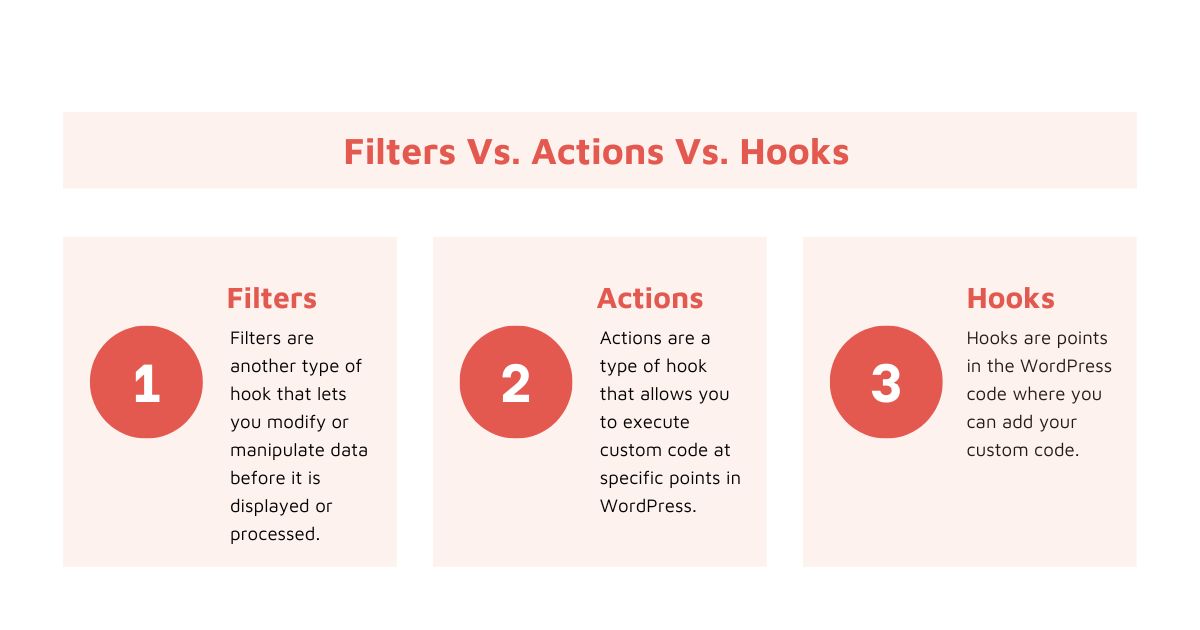What is a Filter? In WordPress development, filters are like tools that help you modify or improve how WordPress works. They take information provided by WordPress, tweak it, and then give it back. Filters allow you to tailor and make WordPress better suited to what you want.
Without filters, WordPress wouldn’t be as adaptable and customizable. They are small bits of code (in PHP) connected to specific events in WordPress. These events trigger the filters, which then change the data generated by the event, allowing for personalized adjustments to how WordPress functions.
Developers, whether working on plugins or themes, often use filters to customize WordPress based on their needs. But even if you’re not a developer, you can enhance your website by using code snippets from the internet. Some of these snippets may include filters and can add new features to your site.
Understanding Filters in WordPress
A filter in WordPress can change how a specific function behaves on your website by modifying the data it gets and sending it back before it shows up on the browser. Filters are often used to edit text, add links to posts, tweak page elements, and adjust database settings like excerpt length or WooCommerce prices.
Filters are handy for altering WordPress’s functionality. Plugin and theme developers use filters to enhance what WordPress can do. You can create filters using functions like add_filter(), remove_filter(), doing_filter(), and has_filter(). Additionally, you can find code snippets in online tutorials to tweak your theme further.
Before making any changes, it’s crucial to back up your WordPress website’s code in case there are coding errors. Adding code directly to theme files is not recommended because it might be removed during theme updates.
Instead, consider creating a site-specific plugin, using a code snippets plugin, or setting up a child theme for changes that persist even when you switch themes.
Filters Vs. Actions Vs. Hooks
In WordPress, a hook is like a designated spot where developers can insert their code to adjust how WordPress behaves, all without modifying the core files. Hooks act as the foundation for building WordPress plugins and themes.

There are two main types of hooks in WordPress:
- Filter hooks: These allow you to modify data as it’s being processed. For example, you can change the output before it’s saved to a database or shown in a user’s browser.
- Action hooks: These let you add custom code that gets activated when specific events happen, like when a theme or plugin is enabled, or when a post is published. They enhance the functionality of your theme or plugin.
Think of action and filter hooks like Lego blocks—they seamlessly connect different parts of WordPress, such as the core, themes, and plugins. They give developers the flexibility to modify standard WordPress events, filters, and actions to suit their specific needs.
Developers can also create their own custom actions and filters, which other developers can use to add more functionality to their WordPress plugins or WordPress themes. It’s like building upon the existing structure to tailor WordPress to individual requirements.
WordPress Filter Example

In this example, we’re using the add_filter() function to add a filter to the the_title hook. This hook allows you to change the title of a post or page before it is displayed on the website, giving you the flexibility to customize it whenever needed.
The callback function, my_custom_title_filter, is the function that the filter uses. It has two parameters and acts as the callback for the filter. In this case, we add a prefix to the title and then return the modified title within the callback function.
As a result, every article or page that is published on the website will have its title affected by this filter, allowing for consistent customization.
Now You Know “What is a Filter in WordPress?”
In summary, WordPress Filters are powerful tools that empower you to customize how WordPress functions. These are brief snippets of PHP code that modify data and get triggered by events, providing WordPress with a high level of flexibility.
Read More: What Is CSS? How To Use CSS In WordPress?
Contact US | ThimPress:
Website: https://thimpress.com/
Fanpage: https://www.facebook.com/ThimPress
YouTube: https://www.youtube.com/c/ThimPressDesign
Twitter (X): https://twitter.com/thimpress